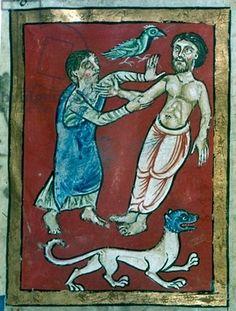-
Table of Contents
- 0. STORY PREFACE
- 1. RABIES - WHAT'S in a NAME?
- 2. RABIES in ANCIENT TIMES
- 3. WHAT IS RABIES?
- 4. LOUIS PASTEUR - EXPERIMENTER
- 5. LOUIS PASTEUR MEETS JOSEPH MEISTER
- 6. A TEEN HERO NAMED JEAN-BAPTISTE JUPILLE
- 7. LOUIS PASTEUR - WORLDWIDE BENEFACTOR
- 8. RABIES as a 21st-CENTURY PROBLEM
- 9. RABIES and ZOMBIES
In the late 12th century, medieval people believed in omens. This miniature drawing depicts a person injured by a rabid dog. Although the patient has a doctor with him, notice the hen at the top of the image. Why is it there? If the chicken’s appetite is good, it provides an omen of recovery. Image online via Wikimedia Commons.
In the ancient world of Greeks and Romans, and in the later medieval world, physicians believed that a human body was comprised of four different “humors.” Those four humors were liquids:
- Black bile;
- Yellow bile;
- Phlegm; and
- Blood
When the four humors were in balance, a person was healthy. If the humors were out of balance, a person was unhealthy.
What did this theory, about humors, have to do with rabies? Animals, according to the theory, also had to have balanced humors and, if they had “a corruption of the humors,” they could develop a sickness (including rabies).
All kinds of things could disrupt the humors balance. Heat, cold, stress, poisoning or even devouring corpses could tip the balance in favor of contracting some disease.
What did those ancient Greeks and Romans think about the transmission of a disease like rabies from animals to humans? How did they treat people who had rabies? And ... did they have a theory about the specific cause of the problem?

Aulus Celsus, a Roman writer who lived from 25 BC to 50 AD (and "left the best account we have of Roman medicine and surgery"), believed that a “virus” (the Latin word for “something slimy and poisonous”) was involved with dog bites. He recommended that if a person were bitten by a rabid dog:
...the virus must be drawn out with a cupping glass.
Celsus was right that rabies is caused by a virus, and he was right that a virus can cause an infection, but he was wrong about the treatment. Anyone showing symptoms of rabies, in the ancient world, was doomed.
What makes rabies so horrific? How is it transmitted from animals to humans? What, if anything, can be done to help people who have this long-dreaded condition?
-
Table of Contents
- 0. STORY PREFACE
- 1. RABIES - WHAT'S in a NAME?
- 2. RABIES in ANCIENT TIMES
- 3. WHAT IS RABIES?
- 4. LOUIS PASTEUR - EXPERIMENTER
- 5. LOUIS PASTEUR MEETS JOSEPH MEISTER
- 6. A TEEN HERO NAMED JEAN-BAPTISTE JUPILLE
- 7. LOUIS PASTEUR - WORLDWIDE BENEFACTOR
- 8. RABIES as a 21st-CENTURY PROBLEM
- 9. RABIES and ZOMBIES
Media Credits
In-text image of Aulus Celsus and his famous book on Medicine, online via Wellcome Library.


 Back
Back
 Next Chapter
Next Chapter

 Back
Back
 Next Chapter
Next Chapter

